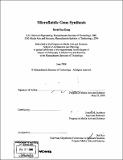| dc.contributor.advisor | Joseph M. Jacobson. | en_US |
| dc.contributor.author | Kong, David Sun, 1979- | en_US |
| dc.contributor.other | Massachusetts Institute of Technology. Dept. of Architecture. Program in Media Arts and Sciences. | en_US |
| dc.date.accessioned | 2009-06-30T16:12:36Z | |
| dc.date.available | 2009-06-30T16:12:36Z | |
| dc.date.issued | 2008 | en_US |
| dc.identifier.uri | http://hdl.handle.net/1721.1/45755 | |
| dc.description | Thesis (Ph. D.)--Massachusetts Institute of Technology, School of Architecture and Planning, Program in Media Arts and Sciences, 2008. | en_US |
| dc.description | "June 2008." | en_US |
| dc.description | Includes bibliographical references. | en_US |
| dc.description.abstract | The ability to synthesize custom de novo DNA constructs rapidly, accurately, and inexpensively is highly desired by researchers, as synthetic genes and longer DNA constructs are enabling to numerous powerful applications in both traditional molecular biology and the emerging field of synthetic biology, from the synthesis of large sets of novel proteins to the complete re-writing of bacterial genomes. However, the current cost of de novo synthesis--driven largely by reagent and handling costs-is a significant barrier to the widespread availability of such technology. The use of microfluidic technology greatly reduces reaction volumes and corresponding reagent and handling costs. Additionally, microfluidic technology enables large numbers of complex reactions to be performed in parallel, while facilitating the automation and integration of multiple processes in a single device. While microfluidic devices have been used to miniaturize a variety of chemical and biological processes, the benefits of such devices have yet to be realized in the area of de novo DNA synthesis. This thesis reports the first demonstration of gene synthesis in a microfluidic environment. A variety of DNA constructs with sizes as large as 1 kb were fabricated in parallel in a multi-chamber microfluidic device at volumes one to two orders of magnitude lower than those utilized in conventional bench top techniques. This thesis also reports on progress toward the direct synthesis of genes from hybrid microfluidic-DNA microarray devices, the integration of microfluidic gene synthesis with on-chip protein synthesis, and the microfluidic hierarchical synthesis of long DNA molecules. | en_US |
| dc.description.statementofresponsibility | by David Sun Kong. | en_US |
| dc.format.extent | 164 leaves | en_US |
| dc.language.iso | eng | en_US |
| dc.publisher | Massachusetts Institute of Technology | en_US |
| dc.rights | M.I.T. theses are protected by
copyright. They may be viewed from this source for any purpose, but
reproduction or distribution in any format is prohibited without written
permission. See provided URL for inquiries about permission. | en_US |
| dc.rights.uri | http://dspace.mit.edu/handle/1721.1/7582 | en_US |
| dc.subject | Architecture. Program in Media Arts and Sciences. | en_US |
| dc.title | Microfluidic gene synthesis | en_US |
| dc.type | Thesis | en_US |
| dc.description.degree | Ph.D. | en_US |
| dc.contributor.department | Program in Media Arts and Sciences (Massachusetts Institute of Technology) | |
| dc.identifier.oclc | 300459476 | en_US |
